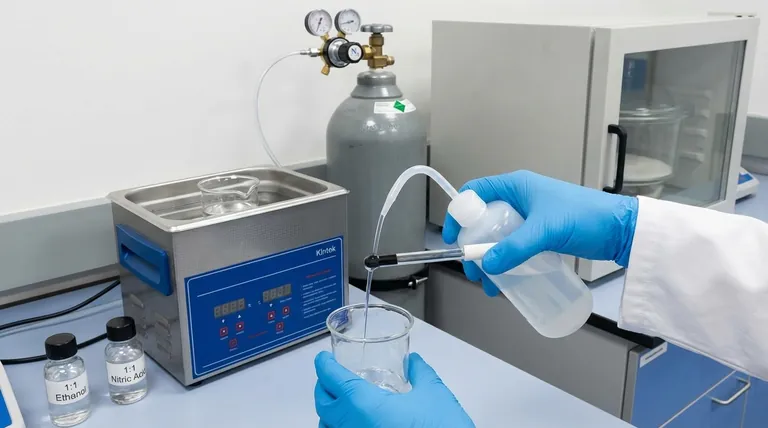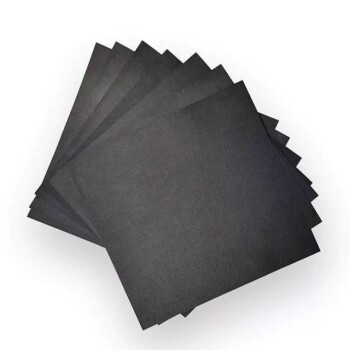The definitive procedure for cleaning a glassy carbon sheet after use involves an immediate rinse with deionized water, followed by a multi-step chemical cleaning for stubborn residues. This chemical process uses sequential, five-second ultrasonic baths in 1:1 nitric acid (only for PTFE-jacketed sheets), 1:1 ethanol or acetone, and finally deionized water. Proper drying with nitrogen gas or air and careful storage are critical final steps.
The performance of a glassy carbon sheet is dictated entirely by its surface condition. Therefore, proper post-use cleaning is not just a cleanup task; it is an essential part of a larger lifecycle of care designed to prevent contamination, ensure data reliability, and preserve the longevity of the instrument.

The Core Principle: A Pristine Surface is Non-Negotiable
A glassy carbon sheet's value in electrochemistry and materials science comes from its inertness and predictable behavior. Any deviation from this baseline can compromise your results.
Why Immediate Cleaning is Critical
Residues from an experiment can harden, polymerize, or react with the carbon surface if left unattended.
Immediate cleaning after use is the single most effective way to prevent the formation of stubborn films that are difficult to remove later.
How Contamination Skews Results
Contaminants, especially organic substances and metal compounds, can act as electroactive species themselves or block active sites on the electrode surface.
This leads to inaccurate measurements, poor reproducibility, and potentially incorrect conclusions drawn from your experimental data.
The Standard Post-Use Cleaning Protocol
Follow this structured protocol to ensure your glassy carbon sheet is properly cleaned and prepared for its next use. Each step is designed to remove specific types of impurities without damaging the delicate surface.
Step 1: Initial Physical Rinse
Immediately after the experiment concludes, thoroughly rinse the entire surface of the sheet with deionized water.
This simple step removes loosely adhered salts and water-soluble compounds before they can dry and crystallize on the surface.
Step 2: Chemical Cleaning for Stubborn Residues
If a simple rinse is insufficient, a more rigorous chemical cleaning is required. This process uses ultrasonication to dislodge strongly-bound impurities.
Perform the following steps sequentially, with each ultrasonic bath lasting no more than 5 seconds to prevent surface damage:
- Nitric Acid Bath: Sonicate in a 1:1 nitric acid solution. Crucially, this step is only safe for sheets jacketed in PTFE (Teflon).
- Solvent Bath: Sonicate in a 1:1 ethanol or acetone solution to remove organic residues.
- Final Water Bath: Sonicate in fresh deionized water to remove any remaining acid or solvent.
Step 3: Proper Drying Technique
After the final rinse, dry the sheet using a gentle stream of nitrogen gas or allow it to air-dry at room temperature.
Never use intense heat, such as an infrared lamp, for baking. This can induce thermal stress and damage the sheet's structure.
Step 4: Safe Storage
Store the clean, dry sheet in a dry, clean, and non-corrosive environment. Placing it in a dedicated container is essential.
For long-term storage, keeping the sheet in a desiccator or with a desiccant is highly recommended to protect it from atmospheric moisture.
Understanding the Trade-offs and Pitfalls
While cleaning is essential, improper techniques can do more harm than good. The goal is to restore the surface, not create new damage.
The Risk of Chemical Damage
Prolonged immersion in strong acid or strong alkali solutions can etch and degrade the glassy carbon surface.
Always adhere to the recommended brief, 5-second sonication times and avoid soaking the sheet for extended periods unless a specific protocol demands it.
The Danger of Physical Damage
Glassy carbon is brittle. Avoid excessive bending, squeezing, or collisions during handling, cleaning, and installation.
When installing the sheet, use a PTFE clamp and apply a torque of no more than 0.5 N·M to prevent cracking. Overheating or exceeding specified current and voltage limits during experiments can also cause irreversible damage.
Pre-Use Polishing vs. Post-Use Cleaning
Remember that post-use cleaning restores a used surface. For highly sensitive measurements, this is not enough.
A full pre-use polishing sequence with successively finer alumina (Al₂O₃) suspensions is often required to create a fresh, mirror-like surface with no scratches. This is a separate, more intensive procedure than standard cleaning.
Making the Right Choice for Your Goal
Your cleaning regimen should match the demands of your experiment. A one-size-fits-all approach is inefficient and can be insufficient for sensitive work.
- If your primary focus is routine analysis with minimal residue: A thorough rinse with deionized water, followed by an ethanol rinse and air-drying, is often sufficient.
- If your primary focus is removing stubborn organic or inorganic films: The full sequential ultrasonic procedure (Nitric Acid -> Solvent -> DI Water) is necessary to restore the surface.
- If your primary focus is high-sensitivity electrochemical analysis: You must combine a rigorous post-use cleaning with a full pre-use polishing routine to ensure a perfectly reproducible starting surface.
Meticulous care of your glassy carbon sheet is the foundation for reliable and repeatable experimental results.
Summary Table:
| Step | Procedure | Key Details |
|---|---|---|
| 1. Initial Rinse | Rinse with deionized water | Removes loose salts and soluble compounds immediately after use. |
| 2. Chemical Cleaning | Sequential 5-second ultrasonic baths | For PTFE-jacketed sheets: 1:1 nitric acid, then 1:1 ethanol/acetone, then deionized water. |
| 3. Drying | Dry with nitrogen gas or air-dry | Avoid intense heat to prevent thermal stress and damage. |
| 4. Storage | Store in a clean, dry container | Use a desiccator for long-term storage to protect from moisture. |
Achieve Pristine Results with KINTEK's Expertise
Your experimental data is only as reliable as your equipment. Proper cleaning is essential for maintaining the integrity of your glassy carbon sheets and ensuring accurate, reproducible results. KINTEK specializes in high-quality lab equipment and consumables, providing the tools and support you need for meticulous surface preparation.
Let our experts help you optimize your cleaning protocols and extend the life of your instruments. Contact KINTEK today to discuss your specific laboratory needs and discover how our solutions can enhance your research outcomes.
Visual Guide

Related Products
- Glassy Carbon Electrochemical Electrode
- Glassy Carbon Sheet RVC for Electrochemical Experiments
- Hydrophilic Carbon Paper TGPH060 for Battery Lab Applications
- Copper Sulfate Reference Electrode for Laboratory Use
- Rotating Platinum Disk Electrode for Electrochemical Applications
People Also Ask
- How to make a glassy carbon electrode? A Guide to the Industrial Pyrolysis Process
- How should a glassy carbon electrode be polished? A Step-by-Step Guide to a Perfect Electrochemical Surface
- How should a glassy carbon electrode be stored during long periods of non-use? Ensure Peak Performance & Longevity
- What are the pre-treatment steps for a glassy carbon electrode before use? Ensure Reliable Electrochemical Data
- What are the common shapes and sizes of glassy carbon electrodes? Key Specs for Reproducible Results



















